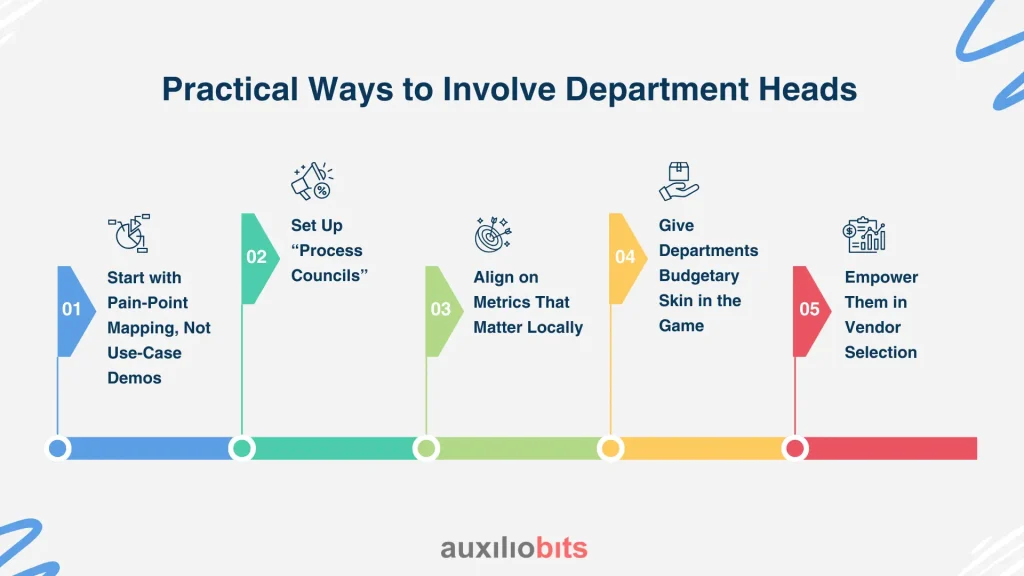
Key Takeaways
- Department heads aren’t optional—they’re central. Their insights, influence, and resource control make them indispensable to automation strategy. Leaving them out leads to brittle, short-lived solutions.
- The biggest failures come from late or token involvement. When leaders are only invited after design decisions are made, adoption drops and friction multiplies.
- Real alignment happens at the departmental level. Global ROI numbers matter to executives, but functional leaders care about metrics like cycle times, backlog reduction, or error rates. Strategy must connect to those local priorities.
- Tensions are natural, not problematic. Conflicting incentives—like risk control vs. speed—should be surfaced and managed, not ignored. A healthy governance model makes trade-offs explicit.
- Sustainable automation is jointly owned. IT ensures scalability and compliance, while department heads ensure relevance and adoption. Programs leaning too far to one side inevitably fail.
Automation programs often stall—not because the technology isn’t sound, but because leaders forget a basic truth: processes don’t live in PowerPoint decks. They live in apartments. That’s where approvals are chased, invoices are corrected, and customers are either delighted or frustrated. So when enterprises plan automation strategies in a boardroom without pulling in department heads, they end up designing workflows in the abstract. On paper, it looks elegant. In reality, it’s brittle.
The role of department heads in automation strategy planning isn’t a box to tick for “stakeholder engagement.” It’s the difference between automations that run smoothly for years and those that quietly break after two months.
Also read: Aligning Automation Goals with Business KPIs: A Strategic Approach
Why Department Heads Are Central to Automation
Executives often assume that automation is an IT project. They sign off on budgets, appoint a steering committee, and hand the ball to a technology lead. But the real owners of the processes—the ones who understand where things go off-script—are the department heads.
Take finance. The CFO might sign off on the vision of “automated invoice matching,” but it’s the Head of Accounts Payable who knows that vendors often submit duplicate invoices, and that the ERP system throws an error when vendor names include an extra comma. Unless those nuances are fed into the design, the bot will fail spectacularly.
Department heads carry:
- Process-level insights—where exceptions pile up, which rules are enforced in practice (not just in policy), and how staff really work around system gaps.
- Political influence—their teams will be the ones adapting to automation. If they’re on board, adoption is smoother. If they’re left out, resistance grows quietly.
- Resource control—testing, training, and process redesign all require departmental staff time. Without leadership buy-in, you won’t get it.
This isn’t just theory. A report on digital operations showed that organizations where functional leaders co-owned automation programs saw 40% faster adoption and significantly fewer abandoned pilots.
Common Mistakes Enterprises Make
You’d think most organizations would know this by now, but the same errors repeat:
1. Inviting department heads too late.
IT finalizes the architecture, consultants prepare slides, and only then are business leaders asked to “validate.” By then, it’s token participation.
2. Treating them as blockers.
A common perception in central strategy teams is that functional leaders “slow things down” with edge-case requests. Ironically, those edge cases are the reality.
3. Assuming uniform priorities.
The COO wants cycle times down, the CMO wants faster customer touchpoints, and the CFO wants cost savings. If these trade-offs aren’t openly discussed with departmental input, the automation strategy becomes lopsided.
4. Measuring adoption by deployment alone.
Department heads know that deployment doesn’t equal impact. They look at backlog reduction, overtime savings, and error rates. When central teams don’t align metrics, frustration builds.
Practical Ways to Involve Department Heads
So how do you bring them in—not as reluctant participants, but as active co-owners?

1. Start with Pain-Point Mapping, Not Use-Case Demos
Instead of showing “what RPA can do,” ask department heads to narrate their biggest process headaches. These conversations surface where automation adds value. An HR leader might not care about unattended bots, but they’ll gladly support automation if it helps reduce manual background checks that delay hiring.
2. Set Up “Process Councils”
Some companies run automation steering groups that include IT, finance, operations, and compliance. But those can get too executive-heavy. A better model is “process councils” chaired by department heads, where automation leads attend as facilitators. This keeps discussions closer to actual operations.
3. Align on Metrics That Matter Locally
Global KPIs like “automation ROI” don’t resonate in departments. For Sales Operations, a more meaningful metric might be “quote-to-cash cycle time.” For Procurement, it might be “vendor onboarding duration.” Let department heads define the operational KPIs automation should move.
4. Give Departments Budgetary Skin in the Game
It may sound harsh, but co-funding creates commitment. When part of the automation spend comes from a departmental budget, leaders scrutinize use cases more carefully and push for results, instead of passively waiting for corporate IT.
5. Empower Them in Vendor Selection
A Head of Customer Service may notice during a demo that a proposed chatbot can’t handle multilingual queries, something central IT would miss. Giving them a real voice in tool evaluation avoids expensive misfits.
A Banking Example
Consider a retail bank that wanted to automate loan origination. The corporate automation team designed a workflow to pre-validate documents using OCR. It looked efficient on paper.
Then the Head of Retail Lending intervened. She pointed out that a huge chunk of applications came from small businesses that often scanned documents from mobile phones. The OCR error rate would have been unacceptable. She pushed for a hybrid approach: bots pre-screen clean inputs, but a human-in-the-loop validates messy ones.
Without her input, the bank would have rolled out a brittle system, frustrating both customers and staff. With her involvement, the program not only succeeded but also avoided reputational damage.
Tensions You Can’t Ignore
It would be dishonest to pretend department heads are always easy allies. Their incentives aren’t always aligned.
- A Head of Operations may resist automation that reduces headcount in their unit, even if it makes enterprise sense.
- A Head of Risk may slow down automation adoption by demanding more controls, clashing with the COO’s push for speed.
- A Sales leader may care more about new revenue tools than fixing manual billing, creating prioritization battles.
These tensions aren’t bad; they’re natural. Pretending otherwise makes planning naive. The real trick is creating governance models that surface disagreements early, so trade-offs are explicit rather than buried.
What Works in the Field
From my experience and from peers who’ve run large-scale automation programs, a few practices stand out:
- Run pilots in departments first, then scale. A finance pilot that reduces reconciliation errors by 70% creates credibility. That success story makes it easier to pull other department heads into the fold.
- Rotate champions. Don’t rely on one enthusiastic leader forever. Rotate departmental champions so automation doesn’t get tied to individual personalities.
- Create feedback loops. A quarterly “automation health check” with each department head surfaces failing bots, changing processes, and new opportunities. This keeps the strategy alive instead of frozen in the original roadmap.
- Celebrate departmental wins publicly. When a Head of Procurement shows that automation cut vendor onboarding time from 15 days to 4, showcase it. Recognition breeds cooperation.
The IT vs. Business Dynamic
One subtle challenge is ownership. IT often feels automation is their domain, given the technical platforms involved. Department heads feel ownership because the processes are theirs. Both are right, and both are wrong.
The reality: automation is a joint asset. IT ensures scalability, security, and compliance. Departments ensure relevance, adoption, and outcomes. Programs that lean too far toward one side fail: IT-led programs become technically perfect but irrelevant; business-led ones become innovative but fragile.
That balance is easier said than done. But acknowledging the tension upfront—and making department heads co-architects, not just “users”—is the only sustainable path.
Final Thoughts
The temptation in strategy planning is to make things clean and linear. Draft a roadmap, assign owners, and put dates on a slide. Reality is messier. Department heads are political actors, operational experts, and, sometimes, bottlenecks. But leaving them out creates bigger messes later.
If you’re serious about automation, involve them not just as advisors, but as co-owners. Accept the debates, the delays, and the contradictions that come with it. Because the alternative—an elegant strategy no one actually uses—is worse.
And if you need proof, walk into any enterprise with a three-year-old automation program. Ask the Head of Finance or HR whether the bots really reduced their pain. If the answer is yes, chances are they were at the table from day one.








